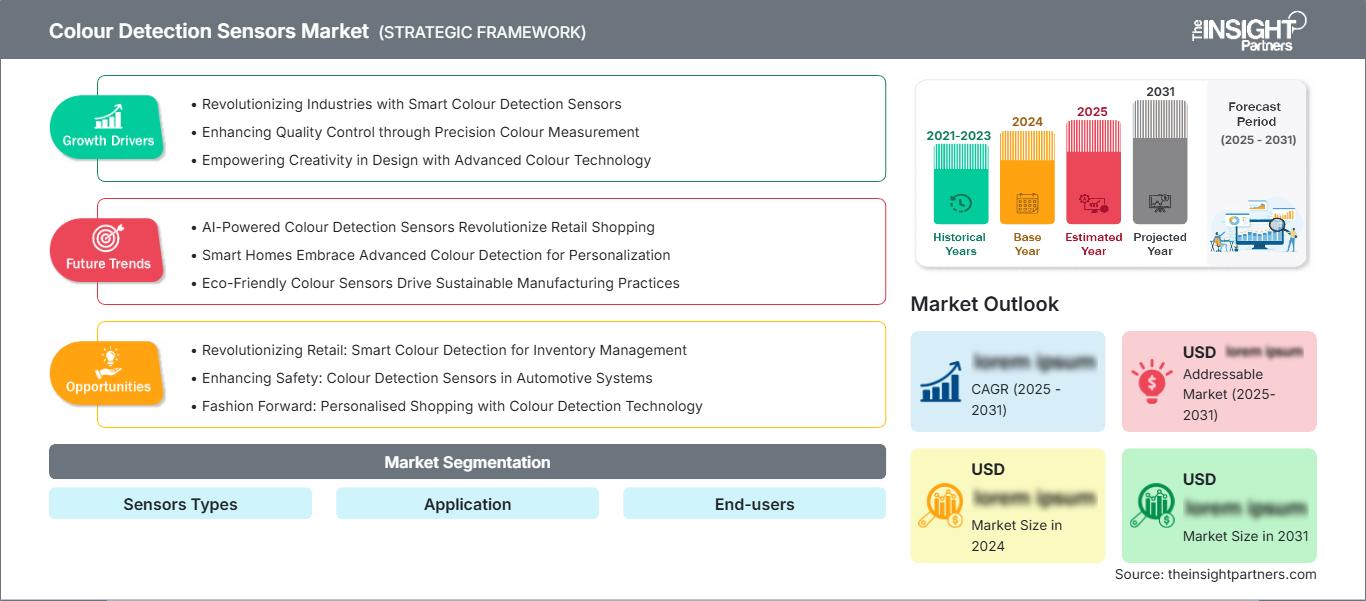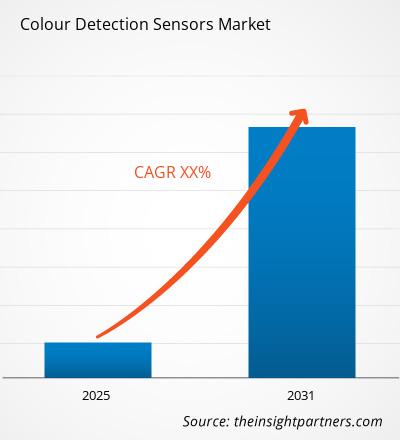Le marché des capteurs de détection de couleur devrait enregistrer un TCAC de XX % entre 2025 et 2031, avec une taille de marché passant de XX millions de dollars américains en 2024 à XX millions de dollars américains d'ici 2031.
Le rapport est classé par types de capteurs et analyse le marché en fonction des applications. Il examine également le marché par utilisateurs finaux. Une ventilation complète est fournie aux niveaux mondial, régional et national pour chacun de ces segments clés. Le rapport inclut la taille du marché et les prévisions pour tous les segments, présentées en dollars américains. Il fournit également des statistiques clés sur la situation actuelle du marché des principaux acteurs, ainsi que des informations sur les tendances actuelles du marché et les opportunités émergentes.
Objectif du rapport
Le rapport sur le marché des capteurs de détection de couleur de The Insight Partners vise à décrire le paysage actuel et la croissance future, les principaux facteurs moteurs, les défis et les opportunités. Cela fournira des informations à diverses parties prenantes commerciales, telles que :
- Fournisseurs/fabricants de technologies : pour comprendre l’évolution de la dynamique du marché et connaître les opportunités de croissance potentielles, leur permettant de prendre des décisions stratégiques éclairées.
- Investisseurs : pour effectuer une analyse complète des tendances concernant le taux de croissance du marché, les projections financières du marché et les opportunités qui existent tout au long de la chaîne de valeur.
- Organismes de réglementation : pour réglementer les politiques et les activités de police sur le marché dans le but de minimiser les abus, de préserver la confiance des investisseurs et de maintenir l’intégrité et la stabilité du marché.
Segmentation du marché des capteurs de détection de couleur Types de capteurs
Application
Utilisateurs finaux
Vous bénéficierez d’une personnalisation sur n’importe quel rapport - gratuitement - y compris des parties de ce rapport, ou une analyse au niveau du pays, un pack de données Excel, ainsi que de profiter d’offres exceptionnelles et de réductions pour les start-ups et les universités
Marché des capteurs de détection de couleur: Perspectives stratégiques

-
Obtenez les principales tendances clés du marché de ce rapport.Cet échantillon GRATUIT comprendra une analyse de données, allant des tendances du marché aux estimations et prévisions.
Moteurs de croissance du marché des capteurs de détection de couleur
- Révolutionner les industries grâce aux capteurs de détection de couleur intelligents
- Améliorer le contrôle qualité grâce à une mesure précise des couleurs
- Stimuler la créativité en design grâce à une technologie de couleur avancée
Tendances futures du marché des capteurs de détection de couleur
- Les capteurs de détection de couleur alimentés par l'IA révolutionnent le commerce de détail
- Les maisons intelligentes adoptent la détection de couleur avancée pour la personnalisation
- Les capteurs de couleur écologiques favorisent des pratiques de fabrication durables
Opportunités du marché des capteurs de détection de couleur
- Révolutionner le commerce de détail : détection de couleur intelligente pour la gestion des stocks
- Améliorer la sécurité : capteurs de détection de couleur dans les systèmes automobiles
- Avant-gardiste : achats personnalisés grâce à la technologie de détection de couleur
Aperçu régional du marché des capteurs de détection de couleur
Les tendances régionales et les facteurs influençant le marché des capteurs de détection de couleur tout au long de la période de prévision ont été analysés en détail par les analystes de The Insight Partners. Cette section aborde également les segments de marché et la répartition géographique des capteurs de détection de couleur en Amérique du Nord, en Europe, en Asie-Pacifique, au Moyen-Orient et en Afrique, ainsi qu'en Amérique du Sud et en Amérique centrale.
Portée du rapport sur le marché des capteurs de détection de couleur
| Attribut de rapport | Détails |
|---|---|
| Taille du marché en 2024 | US$ XX Million |
| Taille du marché par 2031 | US$ XX Million |
| TCAC mondial (2025 - 2031) | XX% |
| Données historiques | 2021-2023 |
| Période de prévision | 2025-2031 |
| Segments couverts | By Types de capteursBy ApplicationBy Utilisateurs finaux |
| Régions et pays couverts |
Amérique du Nord
|
| Leaders du marché et profils d'entreprises clés |
|
Acteurs du marché des capteurs de détection de couleur : densité : comprendre son impact sur la dynamique des entreprises
Le marché des capteurs de détection de couleur connaît une croissance rapide, porté par une demande croissante des utilisateurs finaux, due à des facteurs tels que l'évolution des préférences des consommateurs, les avancées technologiques et une meilleure connaissance des avantages du produit. Face à cette demande croissante, les entreprises élargissent leur offre, innovent pour répondre aux besoins des consommateurs et capitalisent sur les nouvelles tendances, ce qui alimente la croissance du marché.

- Obtenez le Marché des capteurs de détection de couleur Aperçu des principaux acteurs clés
- Analyse historique (2 ans), année de base, prévision (7 ans) avec TCAC
- Analyse PEST et SWOT
- Taille du marché Valeur / Volume - Mondial, Régional, Pays
- Industrie et paysage concurrentiel
- Ensemble de données Excel
Rapports récents
Rapports connexes
Témoignages
Raison d'acheter
- Prise de décision éclairée
- Compréhension de la dynamique du marché
- Analyse concurrentielle
- Connaissances clients
- Prévisions de marché
- Atténuation des risques
- Planification stratégique
- Justification des investissements
- Identification des marchés émergents
- Amélioration des stratégies marketing
- Amélioration de l'efficacité opérationnelle
- Alignement sur les tendances réglementaires






















 Obtenez un échantillon gratuit pour - Marché des capteurs de détection de couleur
Obtenez un échantillon gratuit pour - Marché des capteurs de détection de couleur